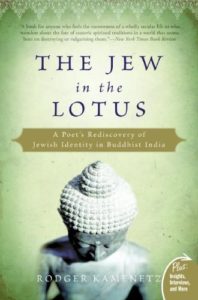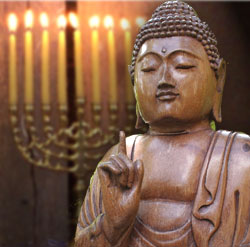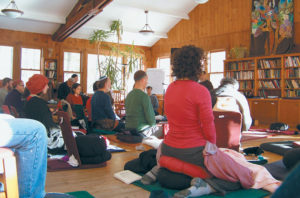American JewBu: Jews, Buddhists, and Religious Change
A book excerpt with an introduction by the author.
Many of America’s most prominent Buddhist teachers have been Jews. Jewish Buddhists, or JewBus as they often call themselves, maintain both Jewish and Buddhist identities. American JewBu: Jews, Buddhists, and Religious Change explores the long history of Judaism’s encounter with Buddhism in the United States, which began in the nineteenth century and steadily developed over time. The book tells the story of how Jewish Buddhists introduced new forms of contemplative practice into Judaism and how they influenced broader Buddhist practices in America. Drawing on in-depth interviews from across the country, the book examines the leading role American Jews have played in the popularization and development of meditation, mindfulness, and other Buddhist practices.
This excerpt comes from the book’s Introduction.
***
American Buddhists like to tell a popular joke. A Jewish woman travels to the Himalayas in search of a famous guru. She heads east, traveling by plane, train, bus, and oxcart until she reaches a far-off Buddhist monastery in Nepal. An old lama in maroon and saffron robes tells her that the guru she is seeking is meditating in a cave at the top of the mountain and cannot be disturbed. She has traveled far and insists that she absolutely must see this guru. The lama eventually relents but requests that she not stay long, bow when addressing the guru, and say no more than eight words to him. With the help of a few lamas, monks, and Sherpa porters, she trudges up the mountain. Exhausted, she reaches the top and the cave where the guru is meditating. Keeping within the eight-word limit, she bows and says what she came to say: “Sheldon, it’s your mother. Enough already, come home!”
 This amusing story pokes fun at the widespread perception that American Jews have a particular affection for Buddhism. Past empirical research seems to support this view. In his sociological survey of seven Buddhist centers in North America, sociologist James Coleman found that 16.5 percent of the Buddhist practitioners in his randomly generated sample were of Jewish backgrounds. Similarly, sociologist Wendy Cadge discovered that nearly a third of those she interviewed at the Cambridge Insight Meditation Center as part of her comparative ethnographic study of Theravada Buddhist organizations in the United States were of Jewish background. Through his research for his best-selling book The Jew in the Lotus, Rodger Kamenetz estimated that Jews represented about 30 percent of Western Buddhist groups in the United States. While scholars do not have precise statistics about the number of Jews involved in Buddhist communities in the United States, it seems safe to assert that the proportion of Jews in Buddhist circles is disproportionate to the percentage of Jews in this country (Jews constitute about 2 to 3 percent of the population).
This amusing story pokes fun at the widespread perception that American Jews have a particular affection for Buddhism. Past empirical research seems to support this view. In his sociological survey of seven Buddhist centers in North America, sociologist James Coleman found that 16.5 percent of the Buddhist practitioners in his randomly generated sample were of Jewish backgrounds. Similarly, sociologist Wendy Cadge discovered that nearly a third of those she interviewed at the Cambridge Insight Meditation Center as part of her comparative ethnographic study of Theravada Buddhist organizations in the United States were of Jewish background. Through his research for his best-selling book The Jew in the Lotus, Rodger Kamenetz estimated that Jews represented about 30 percent of Western Buddhist groups in the United States. While scholars do not have precise statistics about the number of Jews involved in Buddhist communities in the United States, it seems safe to assert that the proportion of Jews in Buddhist circles is disproportionate to the percentage of Jews in this country (Jews constitute about 2 to 3 percent of the population).
These numbers, and their insinuation that Judaism and Buddhism have a distinctive relationship in the United States, motivated this study. I wanted to know why Buddhism appeals to Sheldon and others like him and was curious how Sheldon arrived at the cave at the top of that mountain at all. I also wanted to know if the encounter between Judaism and Buddhism emerged out of the countercultural ethos of the 1960s, as popularly assumed, or if there were earlier antecedent encounters that required unearthing. This book wrestles with these questions by telling the story of how Judaism and Buddhism met and combined in the United States since the late nineteenth century, and how people incorporate these traditions in their daily lives today.
 The distinctive relationship between Judaism and Buddhism has been part of public consciousness in the United States since Kamenetz published The Jew in the Lotus in 1994. His book chronicled the meeting between eight Jewish delegates—a group of progressive rabbis and scholars from across various wings of American Jewish life—and the Dalai Lama in Dharamsala, India. The book is now on its thirty-seventh reprint and even inspired a PBS documentary of the same name featured in film festivals around the world. It also popularized the term “JUBU”—a moniker for a Jewish Buddhist—for a wide audience.
The distinctive relationship between Judaism and Buddhism has been part of public consciousness in the United States since Kamenetz published The Jew in the Lotus in 1994. His book chronicled the meeting between eight Jewish delegates—a group of progressive rabbis and scholars from across various wings of American Jewish life—and the Dalai Lama in Dharamsala, India. The book is now on its thirty-seventh reprint and even inspired a PBS documentary of the same name featured in film festivals around the world. It also popularized the term “JUBU”—a moniker for a Jewish Buddhist—for a wide audience.
Since the publishing of The Jew in the Lotus, countless popular articles, memoirs, books, and blog posts have cast attention on the special relationship between Judaism and Buddhism. Television stations, including PBS and ABC, have produced special programs about the Jewish-Buddhist relationship. Dozens of celebrities, including Goldie Hawn, Leonard Cohen, Steven Seagal, and Mandy Patinkin, have publicly extolled their Jewish Buddhist identities in print and on television. US newspapers—from broad publications like the LA Times to niche outlets like the Jewish Daily Forward or Tricycle: The Buddhist Review—have published articles about such topics as “JuBus—Embracing Judaism and Buddhism,” “Zen and the Art of the BuJu,” and “At One with Dual Devotion.” Recently, Tablet Magazine even ran an article about the Jewish roots of mindfulness meditation in the United States, explaining how a group of four American Jews—Sharon Salzberg, Joseph Goldstein, Jack Kornfield, and Jacqueline Mandell-Schwartz—popularized mindfulness meditation in the United States, and how, in the word of journalist Michelle Goldberg, they “turned a Buddhist spiritual practice into a distinctly American phenomenon—and a multi-billion-dollar industry.”
 Scholars, too, have expressed a curiosity about the Jewish-Buddhist relationship. In The Transformation of American Religion, religious studies scholar Amanda Porterfield noted that Jews “took the lead” in the development of American forms of Buddhism, observing that “one of the most interesting aspects of Buddhism’s merger with American religious and intellectual life is its disproportionate appeal to people with Jewish backgrounds.” Similarly, in his book Buddhism in America, Richard Seager pointed out the “important role played by Jewish Buddhists in the introduction and adaptation of the Buddha’s teachings in America.” And in the new volume Buddhism beyond Borders: New Perspectives on Buddhism in the United States, scholar Mira Niculescu writes about the rise of Jewish mindfulness as an offspring of Western Buddhism in the United States.
Scholars, too, have expressed a curiosity about the Jewish-Buddhist relationship. In The Transformation of American Religion, religious studies scholar Amanda Porterfield noted that Jews “took the lead” in the development of American forms of Buddhism, observing that “one of the most interesting aspects of Buddhism’s merger with American religious and intellectual life is its disproportionate appeal to people with Jewish backgrounds.” Similarly, in his book Buddhism in America, Richard Seager pointed out the “important role played by Jewish Buddhists in the introduction and adaptation of the Buddha’s teachings in America.” And in the new volume Buddhism beyond Borders: New Perspectives on Buddhism in the United States, scholar Mira Niculescu writes about the rise of Jewish mindfulness as an offspring of Western Buddhism in the United States.
Despite this popular and scholarly notice, we know comparatively little about the relationship between Judaism and Buddhism in the United States. We do not know how Jewish Buddhists experience and narrate their multireligious identities; based on these identities, how they have built institutions, new practices, and staked claims in their communities; and what broad social and historical factors explain how these two traditions came together over centuries to produce these identities in the first place. These are the questions at the heart of this book.
 Threaded through the book is an argument that the distinctive social position of American Jews, or what I call the “Jewish social location,” led American Jews to their engagement with Buddhism and fundamentally shaped the character of it. The Jewish social location is the set of orientations produced by the position of Jewish Americans as a distinctively left-liberal, urban, secular, and upper-middle-class religious minority in the United States. Jews occupy a distinctive place in contemporary US society in terms of residential patterns, class, education, occupation, and religious beliefs. More than any other religious or ethnic group in the United States, Jews live in and near the largest American cities, exceed all other groups in socioeconomic status, and surpass all other groups in educational attainment. In addition, Jews consistently fall at the bottom of measures of traditional religious beliefs. Compared to all other ethnic and religious groups (except “religious nones”), they are the least likely to be sure that God exists, to believe that there is an afterlife, and to say that the Bible is the exact word of God. A deep-seated appreciation of this particular sense of Jewish social distinctiveness rests at the heart of the stories in this book. The American Jews in this book also relate deeply to the experience of being a religious minority living in a largely Christian society. The Jewish social location—itself a particular combination of a distinctive demographic, religious, and minority position—propelled Jews into their encounter with Buddhism and shaped the historical mark they left on it. Moreover, it defined the pathways through which Buddhism entered into American Judaism, and to this day, continues to structure how people interpret and knit together ideas from both traditions in framing their identities, creating religious practices, and building organizations.
Threaded through the book is an argument that the distinctive social position of American Jews, or what I call the “Jewish social location,” led American Jews to their engagement with Buddhism and fundamentally shaped the character of it. The Jewish social location is the set of orientations produced by the position of Jewish Americans as a distinctively left-liberal, urban, secular, and upper-middle-class religious minority in the United States. Jews occupy a distinctive place in contemporary US society in terms of residential patterns, class, education, occupation, and religious beliefs. More than any other religious or ethnic group in the United States, Jews live in and near the largest American cities, exceed all other groups in socioeconomic status, and surpass all other groups in educational attainment. In addition, Jews consistently fall at the bottom of measures of traditional religious beliefs. Compared to all other ethnic and religious groups (except “religious nones”), they are the least likely to be sure that God exists, to believe that there is an afterlife, and to say that the Bible is the exact word of God. A deep-seated appreciation of this particular sense of Jewish social distinctiveness rests at the heart of the stories in this book. The American Jews in this book also relate deeply to the experience of being a religious minority living in a largely Christian society. The Jewish social location—itself a particular combination of a distinctive demographic, religious, and minority position—propelled Jews into their encounter with Buddhism and shaped the historical mark they left on it. Moreover, it defined the pathways through which Buddhism entered into American Judaism, and to this day, continues to structure how people interpret and knit together ideas from both traditions in framing their identities, creating religious practices, and building organizations.
Emily Sigalow is a sociologist of contemporary Jewish life in the United States. She has held academic positions at Brandeis University, Duke University, and Wesleyan University. Currently, she is an Executive Director at the United Jewish Appeal Federation of New York where she oversees the Research, Evaluation, and Measurement Department. She has published over a dozen articles and book chapters. She holds a B.A. in Sociology/Anthropology Swarthmore College, a M.A in the History of the Jewish People from Ben Gurion University, and a Ph.D. in Sociology & Near Eastern and Judaic Studies from Brandeis University.